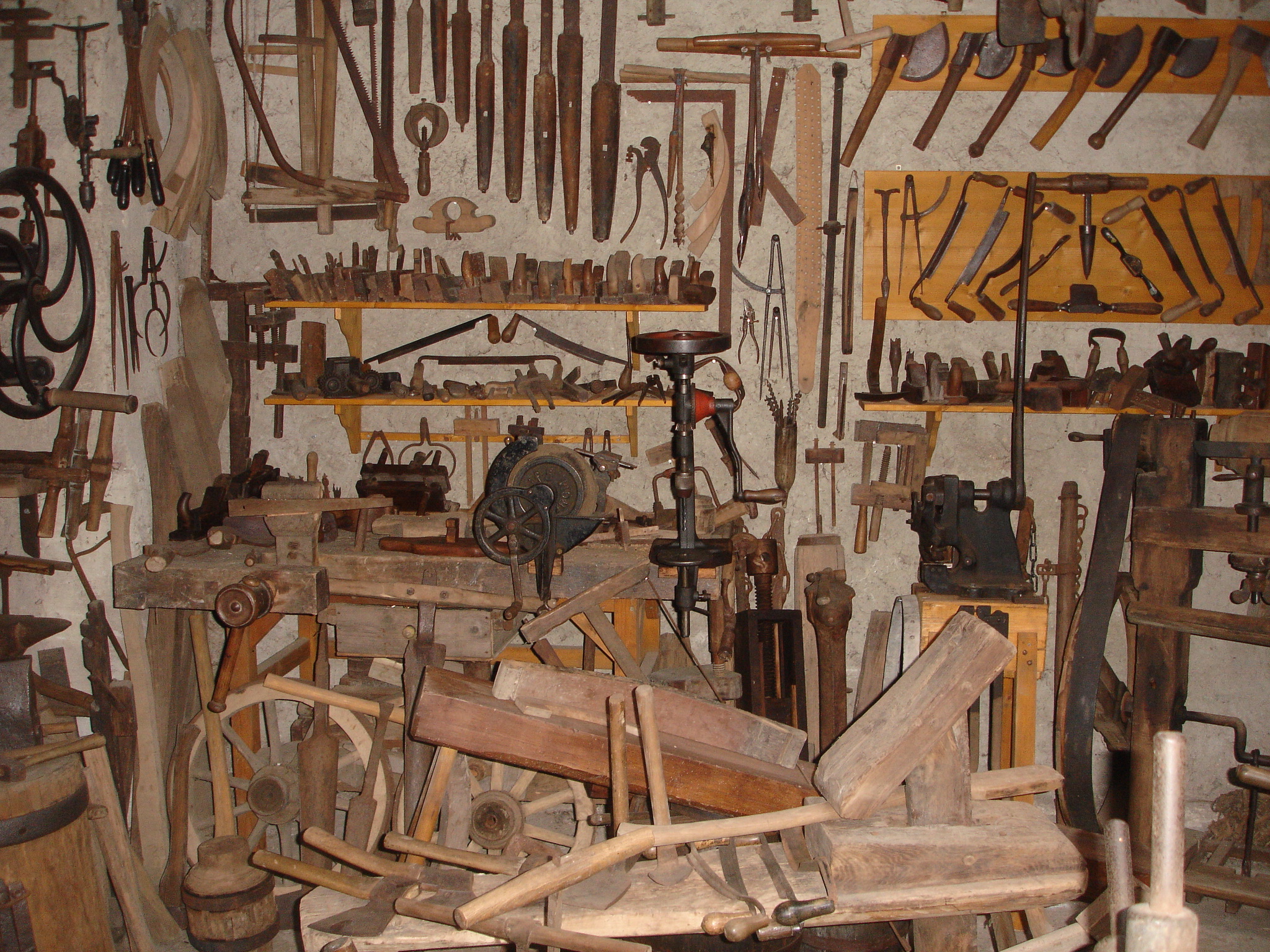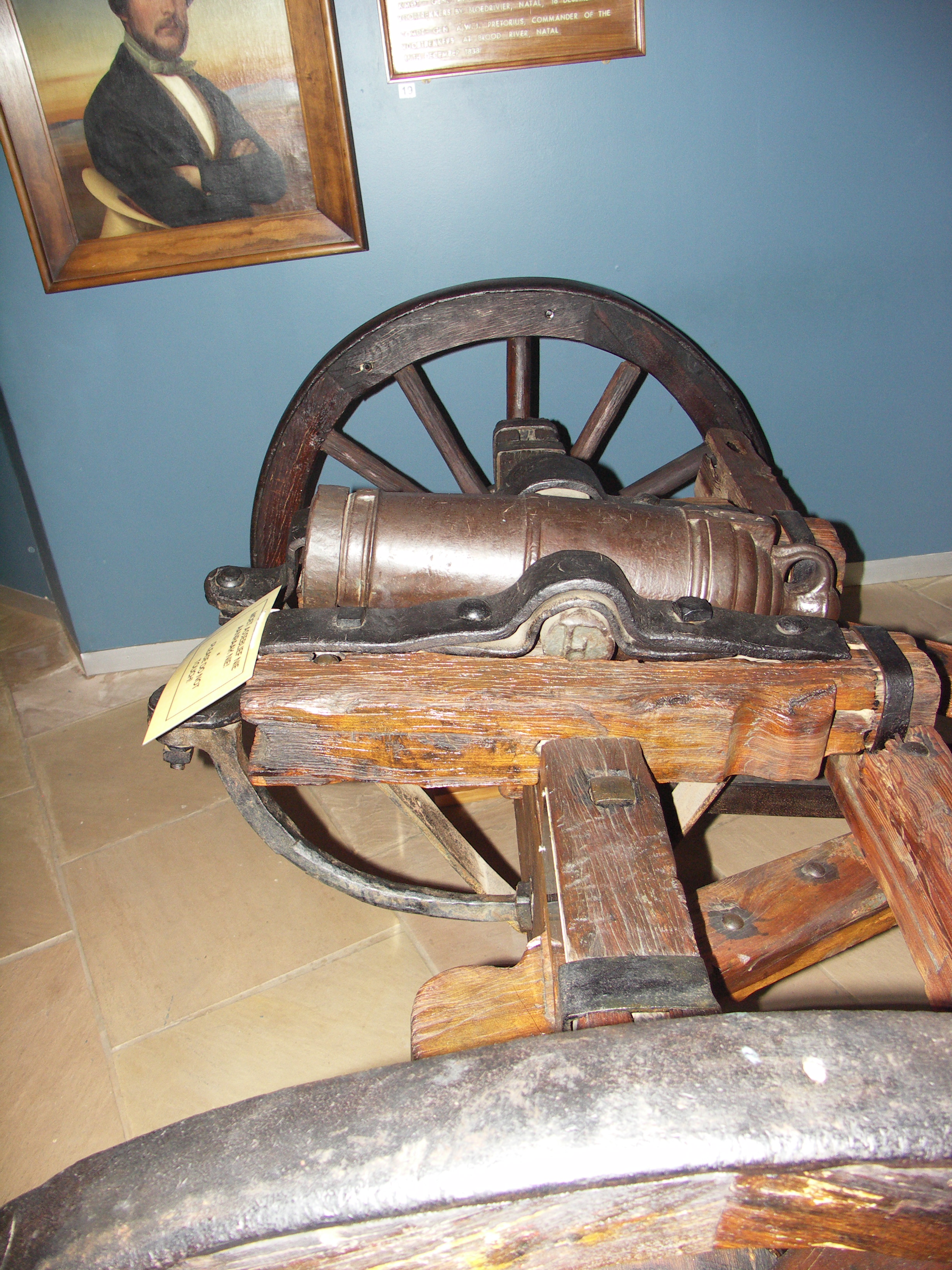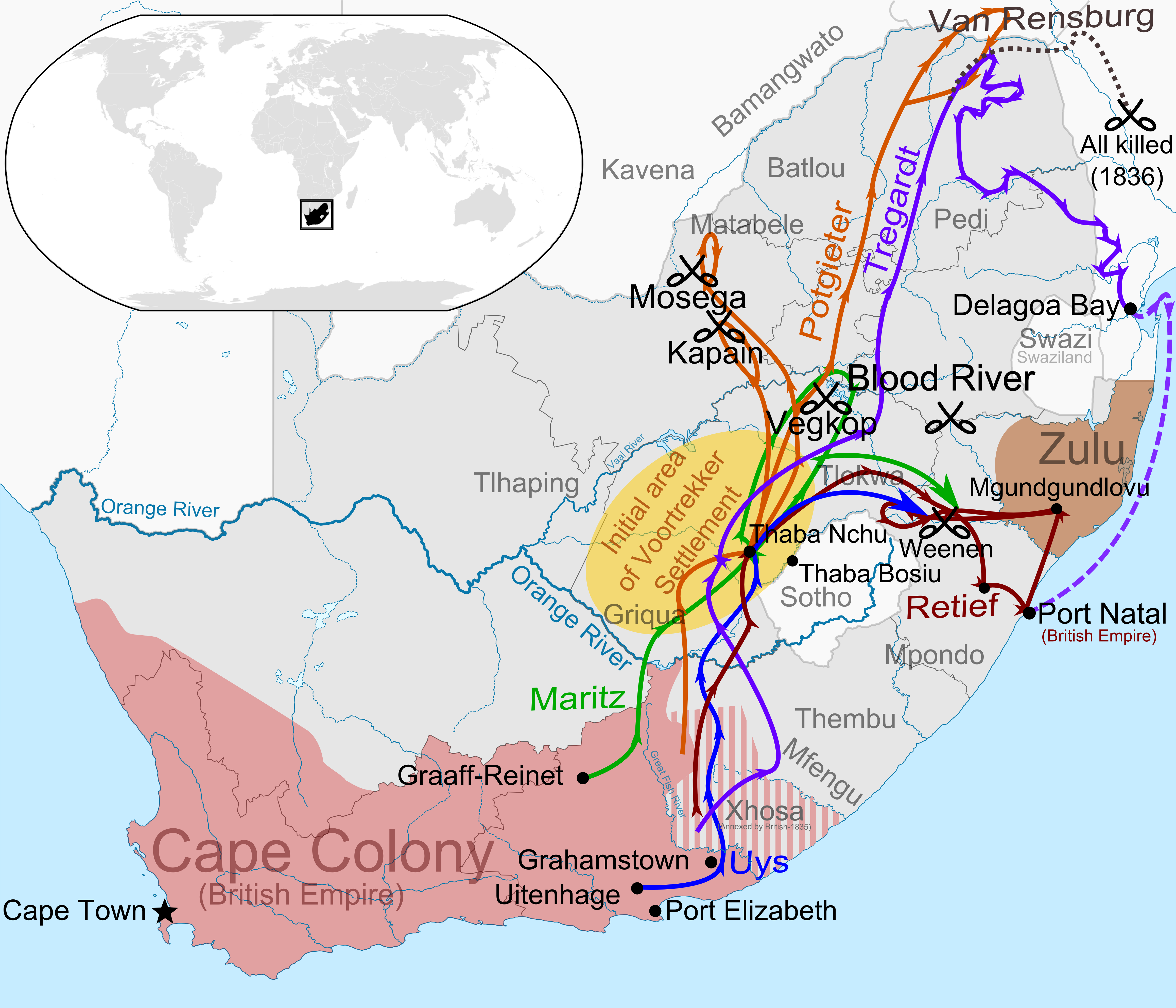|
Ox-wagon
An ox-wagon or bullock wagon is a four-wheeled vehicle pulled by oxen (draught cattle). It was a traditional form of transport, especially in Southern Africa but also in New Zealand and Australia. Ox-wagons were also used in the United States. The first recorded use of an ox-wagon was around 1670, but they continue to be used in some areas up to modern times. Design Ox-wagons are typically drawn by teams of oxen, harnessed in pairs. This gave them a very wide turning circle, the legacy of which are the broad, pleasant boulevards of cities such as Bulawayo, Zimbabwe, which are wide, and Grahamstown, South Africa, which are "wide enough to turn an ox-wagon". The wagon itself is made of various kinds of wood, with the rims of the wheels being covered with tyres of iron, and since the middle of the 19th century the axles have also been made of iron. The back wheels are usually substantially larger than the front ones and rigidly connected to the tray of the vehicle. The front wh ... [...More Info...] [...Related Items...] OR: [Wikipedia] [Google] [Baidu] |
Bullocky
A bullocky is an Australian English term for the driver of a bullock team. The American term is bullwhacker. Bullock drivers were also known as teamsters or carriers. History Bullock teams were in use in Sydney in 1795 when they were used for hauling building materials. The early explorers, Hume and Hovell in 1824 and Charles Sturt, later in 1828-9, also used bullock teams during their explorations.Chisholm, Alec H. (ed.), The Australian Encyclopaedia, Vol. 2, "Bullock-driving", Halstead Press, Sydney, 1963 Before the gold rushes in Australia, in the mid 19th century, bullock drays carried essential food and station supplies to isolated country areas. On return trips they transported wheat, wool, sugar cane, and timber by drays drawn by teams of draught animals (either bullocks or horses) to shipping ports before the advent of rail. They travelled constantly across the landscape, servicing the pastoral stations and settlements far from regional transport hubs and urban ... [...More Info...] [...Related Items...] OR: [Wikipedia] [Google] [Baidu] |
Bullock Team, Colour Postcard
Bullock may refer to: Animals * Bullock (in British English), a castrated male bovine animal of any age * Bullock (in American English), a young bull (an uncastrated male bovine animal) * Bullock (in Australia, India and New Zealand), an ox, an adult male bovine used for draught (usually but not always castrated) Places Canada * Bullock Channel, a water channel in British Columbia, Canada * Bullock Bluff, the northern point of Cortes Island, British Columbia, Canada * Mount Bullock, a mountain in British Columbia, Canada United States * Bullock County, Alabama ** Bullock Correctional Facility, a medium-security Alabama Department of Corrections prison * Bullock, a community in the township of Lanark Highlands, Ontario, Canada * Bullock, New Jersey, an unincorporated community * Bullock, South Dakota, a ghost town * Bullock Creek (South Carolina) Elsewhere * Bullock Harbour, near Dalkey, Ireland * Bullock Park, a townland in County Tyrone, Northern Ireland Other uses * Bu ... [...More Info...] [...Related Items...] OR: [Wikipedia] [Google] [Baidu] |
Wheelwright
A wheelwright is a Artisan, craftsman who builds or repairs wooden wheels. The word is the combination of "wheel" and the word "wright" (which comes from the Old English word "''wryhta''", meaning a worker - as also in shipbuilding, shipwright and arkwright). This occupational name became the English surname ''Wright'', and also appears in surnames like ''Cartwright'' and ''Wainwright''. These tradesmen made wheels for carts (cartwheels), wagons (wains), traps and coaches. They also made the wheels, and often the frames, for spinning wheels, and the belt drives of steam powered machinery. First constructing the hub (called the nave), the spokes and the rim segments called felloes, and assembling them all into a unit working from the center of the wheel outwards. Most wheels were made from wood, but other materials have been used, such as bone and horn (anatomy), horn, for decorative or other purposes. Some earlier construction for wheels such as those used in early chariots wer ... [...More Info...] [...Related Items...] OR: [Wikipedia] [Google] [Baidu] |
Maputo
Maputo () is the Capital city, capital and largest city of Mozambique. Located near the southern end of the country, it is within of the borders with Eswatini and South Africa. The city has a population of 1,088,449 (as of 2017) distributed over a land area of . The Metropolitan Maputo, Maputo metropolitan area includes the neighbouring city of Matola, and has a total population of 2,717,437. Maputo is a port city, with an economy centered on commerce. It is noted for its vibrant cultural scene and distinctive, eclectic architecture. Maputo was formerly named Lourenço Marques (; until 1976). Maputo is situated on Maputo Bay, a large natural bay on the Indian Ocean, near where the rivers Tembe, Mbuluzi, Matola and Infulene converge. The city consists of seven administrative divisions, which are each subdivided into Quarter (urban subdivision), quarters or ''bairros''. The city is surrounded by Maputo Province, but is administered as a self-contained, separate Provinces of Mozam ... [...More Info...] [...Related Items...] OR: [Wikipedia] [Google] [Baidu] |
Barberton, Mpumalanga
Barberton is a town in the Mpumalanga province of South Africa, which has its origin in the 1880s gold rush in the region. It is situated in the De Kaap Valley and is fringed by the Makhonjwa Mountains. It is south of Mbombela and east of Johannesburg. Barberton was the seat of the Umjindi Local Municipality until the day of the 2016 Municipal Elections, when the Umjindi Local Municipality was merged into the Mbombela Local Municipality. History Prehistoric The mountains around Barberton are amongst the oldest in the world, dating back 3.5 billion years, and these mountains include some of the oldest exposed rocks on the planet. These volcanic rocks, which scientists call the Barberton Greenstone Belt, have given direct evidence of the conditions of life on the surface of the very early Earth. In the satellite image, the bare rocks of mountain peaks appear as a pale grey-green, accentuated by the sharp relief of sunlit slopes and their shadows. Deeper shades of gree ... [...More Info...] [...Related Items...] OR: [Wikipedia] [Google] [Baidu] |
Battle Of Blood River
The Battle of Blood River or Voortrekker-Zulu War (16 December 1838) was fought on the bank of the Blood River, Ncome River, in what is today KwaZulu-Natal, South Africa between 464 Voortrekkers ("Pioneers"), led by Andries Pretorius, and an estimated 25,000 to 30,000 Zulu Kingdom, Zulu. Estimations of casualties amounted to over 3,000 of King Dingane kaSenzangakhona, Dingane's soldiers dead, including two Zulu princes competing with Prince Mpande for the Zulu throne. Three Voortrekker commando members were lightly wounded, including Pretorius. The year 1838 was the most difficult period for the Voortrekkers from when they left the Cape Colony, till the end of the Great Trek. They faced many difficulties and much bloodshed before they found freedom and a safe homeland in their Republic of Natalia. This was only achieved after defeating the Zulu Kingdom, at the Battle of Blood River, which took place on Sunday 16 December 1838. This battle would not have taken place if the Zulu K ... [...More Info...] [...Related Items...] OR: [Wikipedia] [Google] [Baidu] |
Laager
A wagon fort, wagon fortress, wagenburg or corral, often referred to as circling the wagons, is a temporary fortification made of wagons arranged into a rectangle, circle, or other shape and possibly joined with each other to produce an improvised military camp. It is also known as a laager (from Afrikaans), especially in historical African contexts, and a tabor (from Polish/Ukrainian/Russian) among the Cossacks. Overview Ammianus Marcellinus, a Roman army officer and historian of the 4th century, describes a Roman army advancing "ad carraginem" as they approach a Gothic camp, notably during the battle of Adrianople. Historians interpret this as a wagon-fort. Notable historical examples include the Hungarians using it during the Hungarian invasions of Europe, the Hussites, who called it ''vozová hradba'' ("wagon wall"), known under the German translation ''Wagenburg'' ("wagon fort/fortress"), ''tabors'' in the armies of the Polish–Lithuanian Commonwealth and Cossacks, and ... [...More Info...] [...Related Items...] OR: [Wikipedia] [Google] [Baidu] |
Cape Colony
The Cape Colony (), also known as the Cape of Good Hope, was a British Empire, British colony in present-day South Africa named after the Cape of Good Hope. It existed from 1795 to 1802, and again from 1806 to 1910, when it united with three other colonies to form the Union of South Africa, then became the Cape Province, which existed even after 1961, when South Africa had become a republic, albeit, temporarily outside the Commonwealth of Nations (1961–94). The British colony was preceded by an earlier corporate colony that became an Dutch Cape Colony, original Dutch colony of the same name, which was established in 1652 by the Dutch East India Company, Dutch East India Company (VOC). The Cape was under VOC rule from 1652 to 1795 and under rule of the Napoleonic Batavian Republic, Batavia Republic from 1803 to 1806. The VOC lost the colony to Kingdom of Great Britain, Great Britain following the 1795 Invasion of the Cape Colony, Battle of Muizenberg, but it was ceded to the ... [...More Info...] [...Related Items...] OR: [Wikipedia] [Google] [Baidu] |
Great Trek
The Great Trek (, ) was a northward migration of Dutch-speaking settlers who travelled by wagon trains from the Cape Colony into the interior of modern South Africa from 1836 onwards, seeking to live beyond the Cape's British colonial administration. The Great Trek resulted from the culmination of tensions between rural descendants of the Cape's original White South Africans, European settlers, known collectively as Boers, and the British Empire, British. It was also reflective of an increasingly common trend among individual Boer communities to pursue an isolationism, isolationist and semi-nomadic lifestyle away from the developing administrative complexities in Cape Town. Boers who took part in the Great Trek identified themselves as ''voortrekkers'', meaning "pioneers" or "pathfinders" in Dutch language, Dutch and Afrikaans language, Afrikaans. The Great Trek led directly to the founding of several autonomous Boer republics, namely the South African Republic (also known sim ... [...More Info...] [...Related Items...] OR: [Wikipedia] [Google] [Baidu] |
Horse
The horse (''Equus ferus caballus'') is a domesticated, one-toed, hoofed mammal. It belongs to the taxonomic family Equidae and is one of two extant subspecies of ''Equus ferus''. The horse has evolved over the past 45 to 55 million years from a small multi-toed creature, '' Eohippus'', into the large, single-toed animal of today. Humans began domesticating horses around 4000 BCE in Central Asia, and their domestication is believed to have been widespread by 3000 BCE. Horses in the subspecies ''caballus'' are domesticated, although some domesticated populations live in the wild as feral horses. These feral populations are not true wild horses, which are horses that have never been domesticated. There is an extensive, specialized vocabulary used to describe equine-related concepts, covering everything from anatomy to life stages, size, colors, markings, breeds, locomotion, and behavior. Horses are adapted to run, allowing them to quickly escape predator ... [...More Info...] [...Related Items...] OR: [Wikipedia] [Google] [Baidu] |
Teamster
A teamster in American English is a truck driver; a person who drives teams of draft animals; or a member of the International Brotherhood of Teamsters, a labor union. In some places, a teamster was called a carter, the name referring to the bullock cart. Originally the term ''teamster'' meant a person who drove a team, usually of oxen, horses, or mules, pulling a wagon, replacing the earlier ''teamer''. This term was common by the time of the Mexican–American War (1848) and the Indian Wars throughout the 19th and early 20th centuries on the American frontier. Another name for the occupation was ''bullwhacker'', related to driving oxen. A teamster might also drive pack animals, such as a muletrain, in which case he was also called a muleteer or muleskinner. Today this person may be called an outfitter or packer. In Australian English, a teamster was also called a bullocker or bullocky and was sometimes used to denote a carrier. From the Revolutionary War at le ... [...More Info...] [...Related Items...] OR: [Wikipedia] [Google] [Baidu] |







